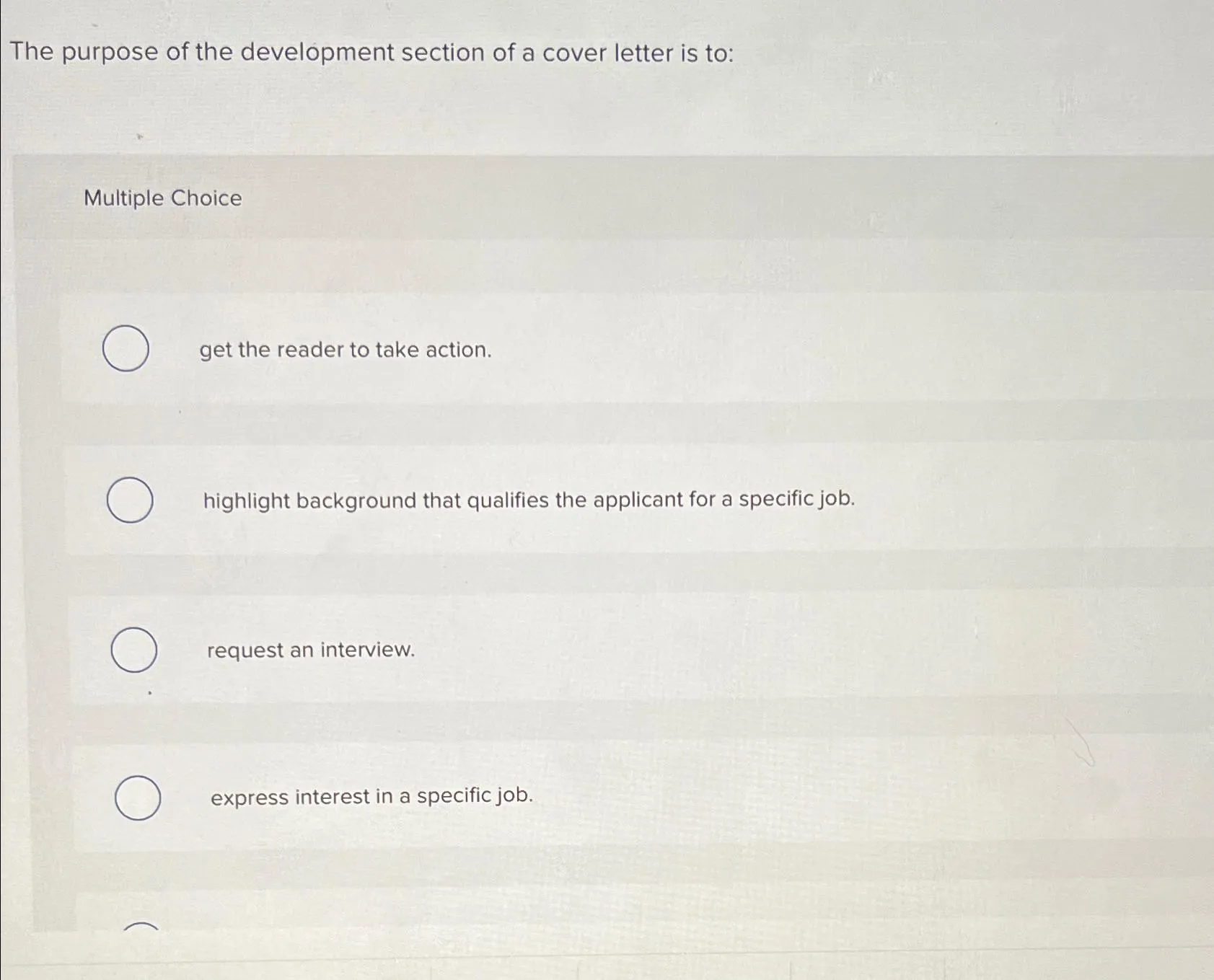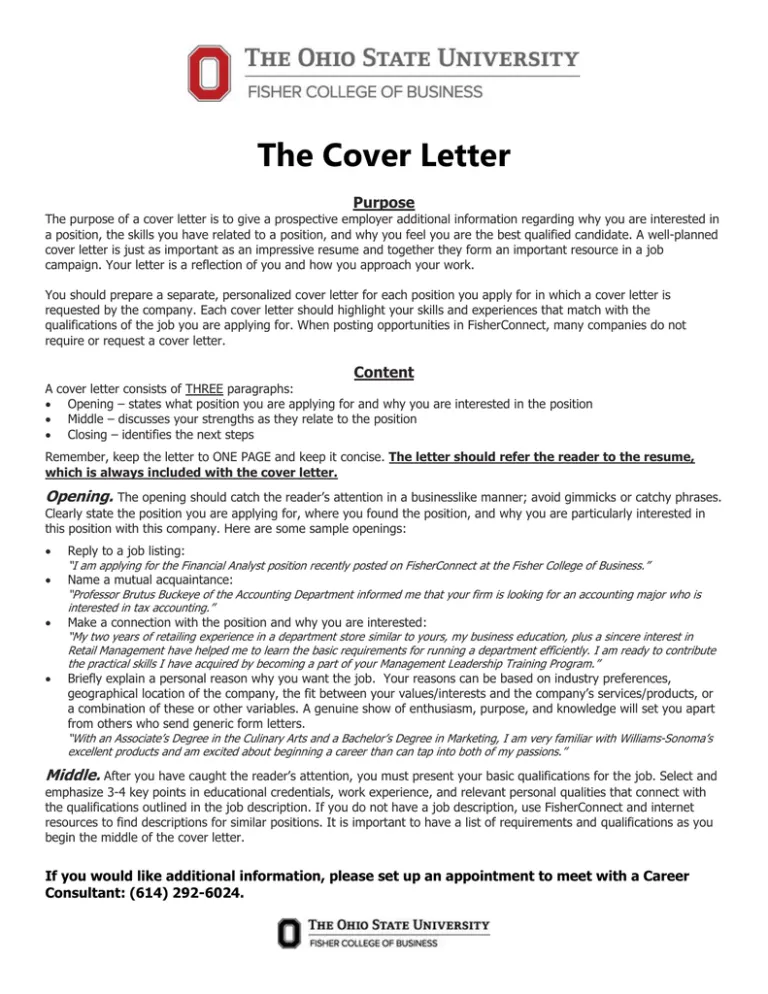What is the Purpose of the Development Section
The development section of a cover letter is a critical component often overlooked by job seekers. Its primary purpose is to demonstrate how your unique skills, experiences, and personality align with the specific requirements and culture of the target job. Unlike a resume, which provides a factual overview of your past, the development section allows you to craft a narrative. This narrative should connect your past achievements with the opportunities the job presents, showcasing your ability to contribute meaningfully to the organization. This section is more than just a summary of your resume’s highlights; it’s a strategic platform to articulate your value proposition and persuade the hiring manager that you are the ideal candidate. By skillfully using the development section, you distinguish yourself, increasing your likelihood of securing an interview and ultimately, the job offer. Focus on showcasing your understanding of the role, emphasizing your unique selling points, and tailoring your message to the job description, making it the heart of your persuasive job application.
Highlighting Skills and Achievements
A key function of the development section is to spotlight the skills and achievements most relevant to the targeted job. Begin by carefully reviewing the job description, identifying the key skills and qualifications. Next, provide concrete examples of how you have successfully utilized these skills in previous roles. It’s insufficient to merely list a skill; instead, demonstrate its practical application. Employ the STAR method (Situation, Task, Action, Result) to structure your examples. Provide the context (situation), detail your responsibilities (task), outline your actions, and most importantly, illustrate the positive outcomes you achieved (results). Emphasize achievements that show your ability to solve problems, improve processes, or enhance team goals. By quantifying your results, you add credibility and a compelling case for your abilities. Tailor your skills and achievement examples to align precisely with each job application, highlighting your value and addressing the employer’s needs. This targeted approach sets your application apart and highlights your suitability for the role.
Best Practices for Highlighting Skills

When highlighting skills, provide a balanced mix of hard and soft skills. Hard skills are technical abilities and specific knowledge needed for a job, while soft skills are the interpersonal and communication abilities essential for workplace success. Always tailor the skills to match the job description, highlighting the most critical ones. Instead of just listing skills, integrate them within the context of your achievements. For example, if the job requires project management skills, describe a successful project, explaining how you utilized those skills to achieve the project goals. Always quantify your achievements whenever possible. Using numbers and data to illustrate your impact and adds credibility. For instance, if you increased efficiency, state the percentage. Also, use action verbs to begin each bullet point or sentence describing your achievements, such as: “Managed,” “Developed,” “Implemented,” or “Increased.” Being specific and providing concrete evidence of your skills in action greatly increases your chances of getting noticed by hiring managers and makes your application stand out from the crowd.
Quantifying Accomplishments
Quantifying your accomplishments is a powerful strategy in the development section. Using measurable data offers tangible proof of your skills and the value you brought to previous roles. Instead of saying you “improved sales,” specify by how much, for example, “Increased sales by 15% in Q4.” Similarly, if you mention reducing costs, state the specific amount saved or the percentage reduction. This approach transforms vague claims into clear, easily understood achievements. Whenever possible, use numbers, percentages, and specific figures to illustrate your accomplishments. For instance, “Managed a team of 10 employees and improved team productivity by 20%.” “Successfully launched three new products, resulting in a 10% increase in market share.” “Streamlined the customer service process, reducing customer complaint resolution time by 30%.” This level of detail demonstrates your impact and shows that you are results-oriented. This attention to detail and your ability to present achievements using data significantly strengthens your cover letter.
Quantifiable Achievements Examples
Here are some examples of how to quantify your achievements in the development section: Instead of: “Improved customer satisfaction,” try: “Increased customer satisfaction scores by 25% through implementing a new feedback system.” Instead of: “Managed social media accounts,” try: “Grew social media following by 30% and engagement by 40% in six months.” Instead of: “Reduced operational costs,” try: “Reduced operational costs by 10% through process improvements, saving the company $50,000 annually.” Instead of: “Led a successful project,” try: “Led a project that was completed two weeks ahead of schedule and under budget by 5%.” These examples clearly demonstrate the value of including measurable data in your cover letter. Adapt these examples to any role, ensuring you tailor the numbers to match your specific skills and accomplishments.
Tailoring to the Job Description

Tailoring the content of your development section to match the job description is essential. This involves a detailed analysis of the job posting to identify the key skills, qualifications, and experiences the employer prioritizes. Highlight the skills and accomplishments that directly align with the employer’s stated requirements. Consider using the same keywords and phrases found in the job description, where appropriate, to demonstrate you possess the necessary qualifications. Go beyond simply listing your skills. Provide concrete examples of how you have utilized your skills. Show that your experience makes you a good fit. The goal is to make it easy for the hiring manager to recognize you as a strong candidate. Demonstrating a clear understanding of the role and the company’s needs is essential. Research the company and the specific role, which will help you frame your skills and experience. A well-tailored cover letter increases your chances of securing an interview and making a positive impression.
Tailoring Strategies for Different Jobs
The tailoring strategies used vary based on the job and industry. For a creative role, such as a graphic designer or writer, you may showcase your portfolio or writing samples. Highlight examples that demonstrate creativity and quality. For a technical role, like a software engineer or data analyst, emphasize your technical skills and experience. Show proficiency in specific tools, technologies, and programming languages and provide examples of their practical use. For management or leadership positions, emphasize your leadership experience. Demonstrate your ability to manage teams and projects, and show examples of how you have successfully led teams, solved problems, and achieved business goals. No matter the role, always tailor your cover letter to its specific requirements. This will show your genuine interest and demonstrate your suitability for the position, making a strong impression on the hiring manager.
Showcasing Personality and Enthusiasm
The development section is an opportunity to showcase your personality and enthusiasm for the job. Maintain a professional tone, but allow your personality to shine through. Show genuine interest in the company and the role. Be enthusiastic about the opportunity, showing your excitement to contribute to the team. Use language that conveys passion and energy, show that you have researched the company and are familiar with its mission, values, and achievements. Connect your personal goals with the company’s. Explain why you are excited about the opportunity and how you believe you can contribute to its success. Express your willingness to learn and grow within the company. Highlight your eagerness to take on new challenges and contribute to the team. Your cover letter is the first impression you make on a potential employer, and showcasing your personality can make a significant difference in setting you apart.
Emphasizing Career Goals

A well-written development section allows you to address your career goals, demonstrating how the job aligns with your professional aspirations. This shows you have a clear vision and see the role as a step towards achieving your objectives. Ensure your career goals align with the company’s values and the specific role. Show how the job provides an opportunity for professional growth. Briefly mention how the role fits into your overall career plan. For example, you might state you’re eager to contribute to the company’s growth, learn new skills, and take on new challenges. Avoid vague statements and specify how the role will enable your growth. Explain how the skills and experiences gained in this role will contribute to your long-term goals. By explicitly linking your career goals to the job requirements, you demonstrate your commitment and motivation, making you a more appealing candidate, allowing the employer to understand your motivations and show you are invested in the position.
Key Elements of Development Section
The development section should be well-structured and organized. Use clear, concise language and avoid jargon. Start with a strong opening statement that highlights your main selling points. Focus on a few key points and support them with concrete examples. Use action verbs to describe accomplishments. Quantify your achievements to make your claims more impactful. Tailor the content to the job description, researching the company and the role. Show enthusiasm and passion for the opportunity. Include a call to action, inviting the hiring manager to review your resume or schedule an interview. Keep it brief, aiming for three to five paragraphs. Maintain a professional and enthusiastic tone. Following these key elements will help you create a section that showcases your skills, experience, and value to the employer effectively.
Dos and Don’ts
Do: Tailor your cover letter to each job, highlight your key skills, quantify accomplishments, and show enthusiasm. Don’t: Use generic cover letters, repeat your resume, include irrelevant information, or be overly formal. Do: Proofread for grammar and spelling errors, research the company and role, and focus on achievements. Don’t: Include negative information or reasons for leaving past jobs. Emphasize your strengths and positive qualities.
Effective Language and Tone

Your language and tone greatly impact the development section. Use professional and formal language, but avoid sounding stiff. Aim for an enthusiastic, confident, and engaging tone. Use strong action verbs. Avoid jargon unless the hiring manager will understand it. Provide concrete examples, using positive language. Avoid negative comments. Focus on how your strengths align with the job requirements. Show genuine interest in the company. Your cover letter is a reflection of your abilities, making the development section a crucial opportunity to showcase your best qualities.
Formatting Tips for Impact
Effective formatting boosts readability and impact. Keep your paragraphs concise, use headings and subheadings, and use bullet points to list achievements. Choose a professional font and size (11 or 12 points). Use white space effectively. Proofread carefully. Maintain consistent formatting throughout your document. Ensure your presentation is clean and easy to read to increase your chances of getting an interview.
